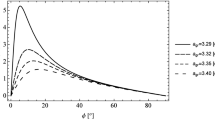Abstract
Results of dynamic modeling of the dust tail formation for the comet C/2011 L4 (PANSTARRS) are presented. To simulate the dust tail, the trajectories of 100 million dust particles were traced. Their sizes, ejection moments, outflow directions, and initial velocities were defined by the Monte Carlo algorithm. The obtained three-dimensional model tail was projected onto the celestial sphere to compare with the observed image. The brightness distribution and synchronic features in the comet tail were reconstructed. According to our model experiments, the observed tail could be formed by particles with sizes from 0.22 to 82 μm, with ejection velocities from 460 to 12 m/s, and with a power index of the size distribution of −3.1. Our model experiments showed that the rotation period of the comet is 17.2 hours.
Similar content being viewed by others
References
S. V. Kharchuk and P. P. Korsun, “Formation of band structures in the dust tails of comets,” Visn. Astron. Shk. 8, 80–86 (2012).
J. A. Fernandez and K. Jockers, “Nature and origin of comets,” Rep. Prog. Phys. 46, 665–772 (1983).
M. Fulle, “Motion of cometary dust,” in Comets II, Ed. by M. C. Festou, H. U. Keller, H. A. Weaver (Univ. Arizona Press, Tucson, 2004), pp. 565–575.
K. Jockers, “Observations of scattered light from cometary dust and their interpretation,” Earth, Moon, Planets 79, 221–245 (1997).
S. V. Kharchuk and P. P. Korsun, “Striated features in the dust tail of comet C/2006 P1 (McNaught),” Kinematics Phys. Celestial Bodies 26, 322–325 (2010).
P. P. Korsun, I. V. Kulyk, I. V. Ivanova et al., “Dust tail of the active distant comet C/2003 WT42 (LINEAR) studies with photometric and spectroscopic observations,” Icarus 210, 916–929 (2010).
N. H. Samarasinha, B. E. A. Mueller, M. J. S. Belton, and L. Jorda, “Rotation of cometary nuclei,” in Comets II, Ed. by M. C. Festou, H. U. Keller, and H.A. Weaver (Univ. Arizona Press, Tucson, 2004), pp. 281–299.
A. Schnabel, Infoblatt für den Kometen C/2011 L4 PANSTARRS (info sheet, 2013).
Z. Sekanina, M. S. Hanner, E. K. Jessberger, and M. N. Fomenkova, “Cometary dust,” in Interplanetary Dust, Ed. by E. Gruen, B. A. S. Gustafson, S. F. Dermott, and H. Fechtig (Springer, Heidelberg, 2001), pp. 95–161.
Z. Sekanina, S. M. Larson, O. Hainaut, A. Smette, and R. M. West, “Major outburst of periodic comet Halley at a heliocentric distance of 14 AU,” Astron. Astrophys. 263, 367–386 (1992).
Author information
Authors and Affiliations
Corresponding author
Additional information
Original Russian Text © S.V. Kharchuk, P.P. Korsun, 2015, published in Kinematika i Fizika Nebesnykh Tel, 2015, Vol. 31, No. 1, pp. 52–57.
About this article
Cite this article
Kharchuk, S.V., Korsun, P.P. Model of the dust tail of comet C/2011 L4 (PANSTARRS). Kinemat. Phys. Celest. Bodies 31, 34–36 (2015). https://doi.org/10.3103/S0884591315010043
Received:
Published:
Issue Date:
DOI: https://doi.org/10.3103/S0884591315010043



